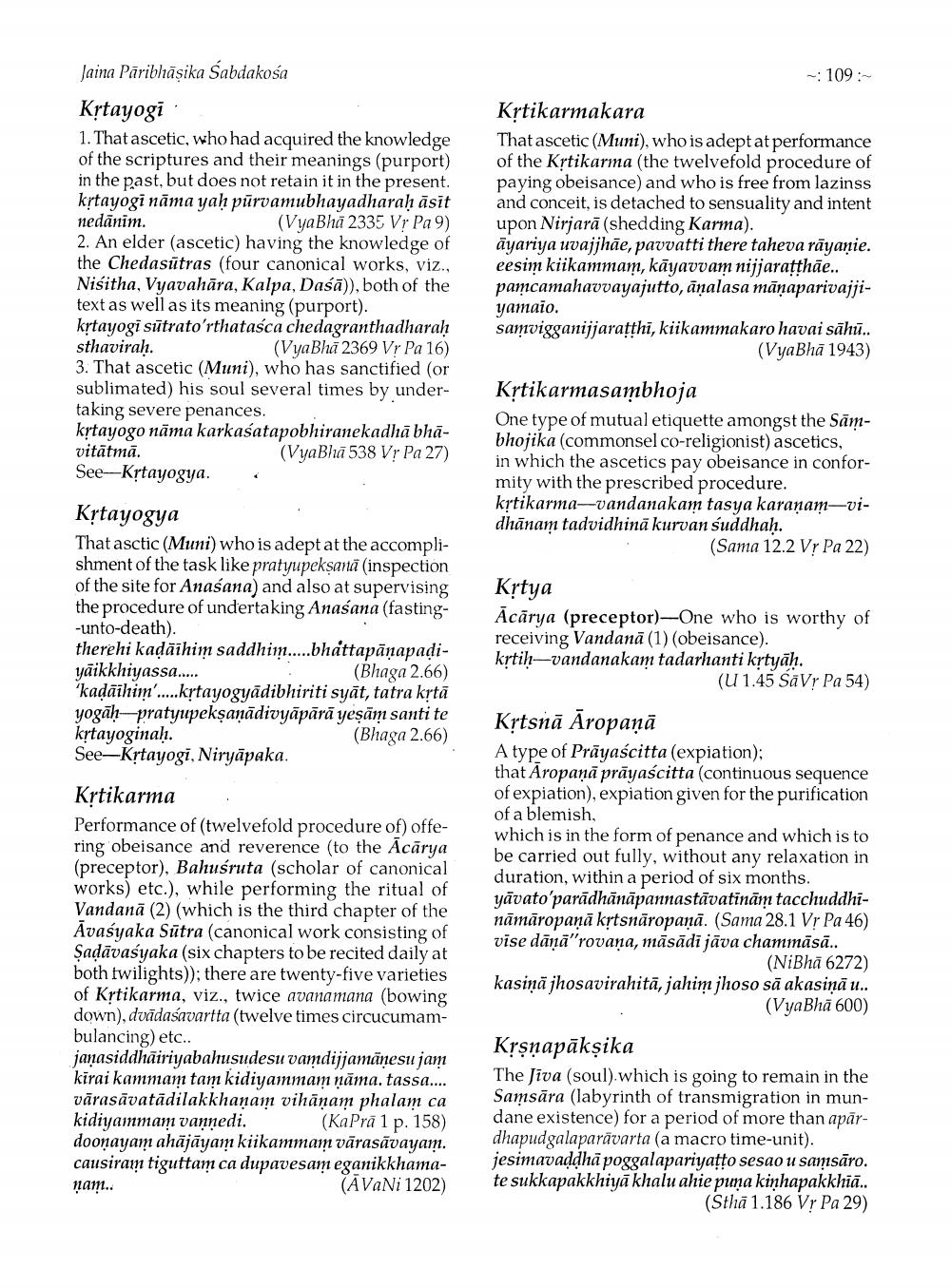________________
- 109 :
Jaina Pāribliāșika Šabdakosa Krtayogi 1. That ascetic, who had acquired the knowledge of the scriptures and their meanings (purport) in the past, but does not retain it in the present. ketayogi nāma yah pūrvamubhayadharah ăsit nedānim.
(VyaBhā 2335 Vr Pa 9) 2. An elder (ascetic) having the knowledge of the Chedasūtras (four canonical works, viz., Nisitha, Vyavahāra, Kalpa, Dasā)), both of the text as well as its meaning (purport). kytayogi sūtrato'rthatasca chedagranthadharah sthavirah.
(VyaBhā 2369 Vr Pa 16) 3. That ascetic (Muni), who has sanctified (or sublimated) his soul several times by undertaking severe penances. krtayogo nāma karkasatapobhiranekadhābhāvitātmā.
(Vya Bhā538 Vr Pa 27) See-Krtayogya.
Krtikarmakara That ascetic (Muni), who is adept at performance of the Krtikarma (the twelvefold procedure of paying obeisance) and who is free from lazinss and conceit, is detached to sensuality and intent upon Nirjarā (shedding Karma). āyariya uvajjhāe, pavvatti there taheva rāyaṇie. eesim kiikammam, kāyavvam nijjaratthāe.. pamcamahavvayajutto, analasa māņaparivajjiyamaio. samvigganijjarathi, kiikammakaro havai sähū..
(VyaBhā 1943) Krtikarmasambhoja One type of mutual etiquette amongst the Sāmbhojika (commonsel co-religionist) ascetics, in which the ascetics pay obeisance in conformity with the prescribed procedure. křtikarma-vandanakam tasya karanam-vidhānam tadvidhinä kurvan suddhah.
(Sama 12.2 V? Pa 22)
Kệtayogya That asctic (Muni) who is adept at the accomplishment of the task like pratyupekşanä (inspection of the site for Anaśana) and also at supervising the procedure of undertaking Anasana (fasting-unto-death). therehi kaņāihim saddhim.....bhattapāņapadiyāikkhiyassa.....
(Bhaga 2.66) 'kadāihim'.....kytayogyādibhiriti syāt, tatra krtā yogāḥ--pratyupekṣaṇādivyāpārā yeşām santi te krtayoginah.
(Bhaga 2.66) See-Kıtayogi, Niryāpaka.
Krtya Ācārya (preceptor)-One who is worthy of receiving Vandanā (1) (obeisance). krtih-vandanakam tadarhanti krtyāh.
(U 1.45 SãV? Pa 54)
Krtikarma Performance of (twelvefold procedure of) offering obeisance and reverence (to the Acārya (preceptor), Bahuśruta (scholar of canonical works) etc.), while performing the ritual of Vandanā (2) (which is the third chapter of the Āvasyaka Sūtra (canonical work consisting of Şadāvasyaka (six chapters to be recited daily at both twilights)); there are twenty-five varieties of Kytikarma, viz., twice avanamana (bowing down), dvīdasavartta (twelve times circucumambulancing) etc.. janasiddhāiriyabahusudesu vamdijjamänesu jam kirai kammam tam kidiyammam ņāma. tassa.... vārasāvatādilakkhanam vihānam phalam ca kidiyammam vannedi. (KaPrā 1 p. 158) dooņayam ahājāyam kiikammam vārasāvayam. causiram tiguttam ca dupavesameganikkhamanat..
(AVaNi 1202)
Kệtsnā Āropaņā A type of Prāyascitta (expiation); that Aropaņā prāyaścitta (continuous sequence of expiation), expiation given for the purification of a blemish, which is in the form of penance and which is to be carried out fully, without any relaxation in duration, within a period of six months. yāvato'parādhānāpannastāvatinām tacchuddhināmāropaņā krtsnāropaņā. (Sama 28.1 Vr Pa 46) vise dāņā"rovana, māsādi jāva chammāsā..
(NiBhā 6272) kasiņā jhosavirahitā, jahim jhoso sa akasiņā u..
(VyaBhā 600)
Krşņapākṣika The Jiva (soul).which is going to remain in the Samsāra (labyrinth of transmigration in mundane existence) for a period of more than apardhapudgalaparävarta (a macro time-unit). jesimavaddhā poggalapariyatto sesao u samsāro. te sukkapakkhiya khalu ahie puna kinhapakkhiā..
(Sthā 1.186 Vr Pa 29)




